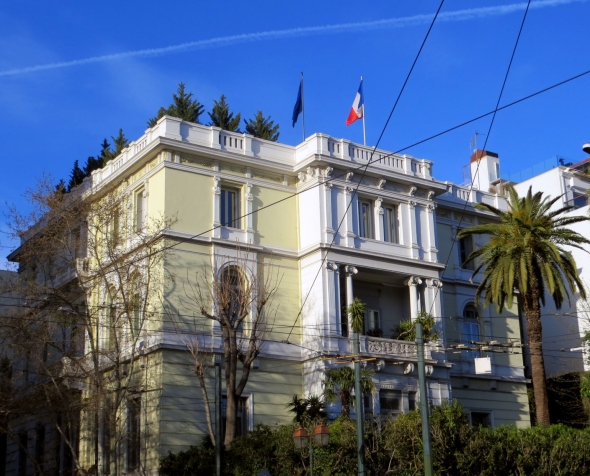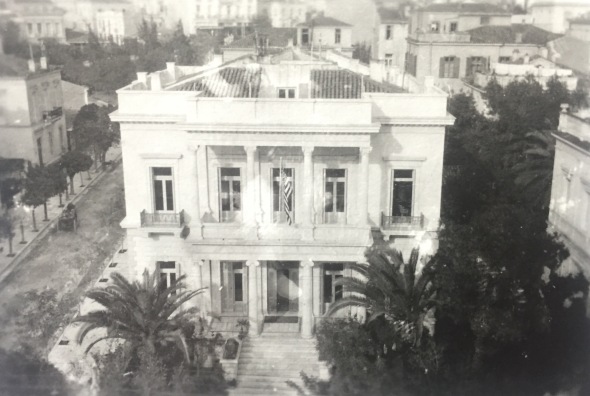Professors to the Rescue: Americans in the Aegean at the End of the Great War, 1918-1919.
Posted: January 3, 2019 Filed under: Archival Research, Biography, History of Archaeology, Philhellenism | Tags: A. Winsor Weld, American Red Cross Greek Commission, Cyril G. Hopkins, Edward Capps, Henry B. Dewing, Horace S. Oakley 4 Comments“Islands and coast Asia Minor still crowded with refugees. Stop. Number there still to be repatriated estimated three hundred thousand. Stop. We are maintaining three stations in Mytilene district clothing alone being available, but food urgently needed. Stop. Above statements based on personal inspection this Commission. Stop. We recommend that work in Aegean be immediately extended to other islands like Chios, Samos and to opposite coast which can be reached by sea transport which can be secured by Greek governments. Stop.”
The text quoted above is a small portion of a long telegram (47 lines) that Colonel Edward Capps sent to Harvey D. Gibson, member of the American Red Cross War Council in Paris, on December 12, 1918 (NACP, Greece, ARC Commission to, 964.62/08). The telegram reported the activities of the American Red Cross (ARC hereafter) since arrival of its Greek Commission in Athens on October 23rd.
 This is not the first time I am writing about the activities of the ARC in Greece. In 2011, together with Jack L. Davis, then Director of the American School of Classical Studies at Athens (ASCSA or the School hereafter), we organized and subsequently published the proceedings of a conference titled Philhellenism, Philanthropy, or Political Convenience: American Archaeology in Greece (Princeton 2013). Davis’s paper, “The American School of Classical Studies and the Politics of Volunteerism,” discussed the involvement of members of the ASCSA, through enlistment in the Greek Commission of the ARC, in humanitarian aid in eastern Macedonia, as well as in the repatriation of Greek citizens who had been taken as hostages to Bulgaria. Later in 2015, on the occasion of the centenary of the Battle of Gallipoli, I was invited to participate in a conference about The First World War in the Mediterranean and the Role of Lemnos, with a paper that discussed the humanitarian activities of the ARC Greek Commission in the eastern Aegean at the end of the Great War. Read the rest of this entry »
This is not the first time I am writing about the activities of the ARC in Greece. In 2011, together with Jack L. Davis, then Director of the American School of Classical Studies at Athens (ASCSA or the School hereafter), we organized and subsequently published the proceedings of a conference titled Philhellenism, Philanthropy, or Political Convenience: American Archaeology in Greece (Princeton 2013). Davis’s paper, “The American School of Classical Studies and the Politics of Volunteerism,” discussed the involvement of members of the ASCSA, through enlistment in the Greek Commission of the ARC, in humanitarian aid in eastern Macedonia, as well as in the repatriation of Greek citizens who had been taken as hostages to Bulgaria. Later in 2015, on the occasion of the centenary of the Battle of Gallipoli, I was invited to participate in a conference about The First World War in the Mediterranean and the Role of Lemnos, with a paper that discussed the humanitarian activities of the ARC Greek Commission in the eastern Aegean at the end of the Great War. Read the rest of this entry »
The Man from Damascus, the Good Wife, and Baby Solon: R.I.P. at the American School of Classical Studies at Athens
Posted: December 2, 2016 Filed under: Archaeology, Archival Research, Biography, History of Archaeology, Intellectual HIstory, Modern Greek History | Tags: A. Winsor Weld, American School of Classical Studies at Athens, Charles Edward Prior Merlin, French Embassy at Athens, Hôtel Merlin de Douai, Ida Thallon Hill, Thomas Dwight Goodell 5 Comments
ASCSA Library, 1902
“You enter a reception hall of marble and go up a flight of marble steps which give the effect of entering a museum, as there are marble busts and old sculptures round that have been dug up…” Major A. Winsor Weld wrote to his wife on October 26th, 1918, upon entering the American School of Classical Studies at Athens (ASCSA or School hereafter). He and six other officers of the American Red Cross including Lieutenant Colonel Edward Capps would live in the School’s premises until July of 1919. (At the time one entered the Library through the Director’s residence.) Although the ASCSA was already building a small collection of antiquities –mostly pottery sherds and other small objects picked up on walks and informal surveys– the antiquities Weld described are of a different scale. The busts he refers to must have been plaster casts of originals similar to the one displayed above the fireplace mantle in the Library in a photo from 1902. I believe that the other “old sculptures” on display, the ones that “have been dug up,” were three Roman marble funerary reliefs unearthed in 1894, at the corner of Vasilissis Sophias (then Kephissias) and Merlin (then Academy) street, exactly opposite the Palace (now the Greek Parliament), during the construction of a mansion by Charles Edward Prior Merlin (1850-1898). Named after one of Merlin’s French ancestors, the “Hôtel Merlin de Douai” has housed the French Embassy since 1896.

The “Hôtel Merlin de Douai” (French Embassy at Athens)
“In digging for the foundations of the large house which Mr. C. Merlin, the well-known artist and photographer of Athens, is building at the corner of Academy and Kephissia Streets, the workmen came upon considerable remains of an ancient cemetery. At my suggestion Mr. Merlin made over to the American School the right of publishing these discoveries, and afterwards generously presented to the School three reliefs and one other inscribed stone, together with some smaller fragments. The finds were made in the autumn of 1894. Only a part of them came under my observation at the time; hence the description of the graves and their location rests in part upon the accounts of Mr. Merlin and his workmen” reported Thomas Dwight Goodell a year later (American Journal of Archaeology 10, 1895, pp. 469-479).
Athens 1918: “In Every Way a Much More Attractive City than Rome”
Posted: December 1, 2015 Filed under: Archival Research, History of Archaeology, Modern Greek History | Tags: 1918-1919, A. Winsor Weld, American Red Cross Greek Commission, American School of Classical Studies at Athens, Aspasia Manou, Athens, Edward Capps, Great War, Greek Cuisine, Josephine Kelly, Kephissias Street, King Alexander of Greece 4 Comments
The headquarters of the American Red Cross in Athens, 1918-1920. Source: Horace S. Oakley Papers, Newberry Library, Chicago.
This description of Athens was penned by A. Winsor Weld (1869-1956), one of the deputy commissioners of the American Red Cross Commission to Greece, a few days after his arrival in October 1918. Weld, an investment broker from Boston and a graduate of Harvard University (B.A. 1891), was one of a million Americans who responded to President Wilson’s call to provide military and civilian aid to many European countries at the end of WW I. The mission to Greece was organized in June and July of 1918 in response to an appeal from the Greek Red Cross (Capps 1919, 9).
There came from America to do the work 103 persons (60 men and 43 women), and several others were recruited in Europe. They enlisted in the service of the American Red Cross from all parts of the United States, and represented all manner of occupations and professions. There were business men, lawyers, bankers, physicians, preachers, teachers, farmers and mechanics, and among the women, trained nurses, stenographers and social workers. The authority of the Commission was vested in the Commissioner, who held the rank of Lieutenant-Colonel, and seven Deputy Commissioners with the rank of Major.

